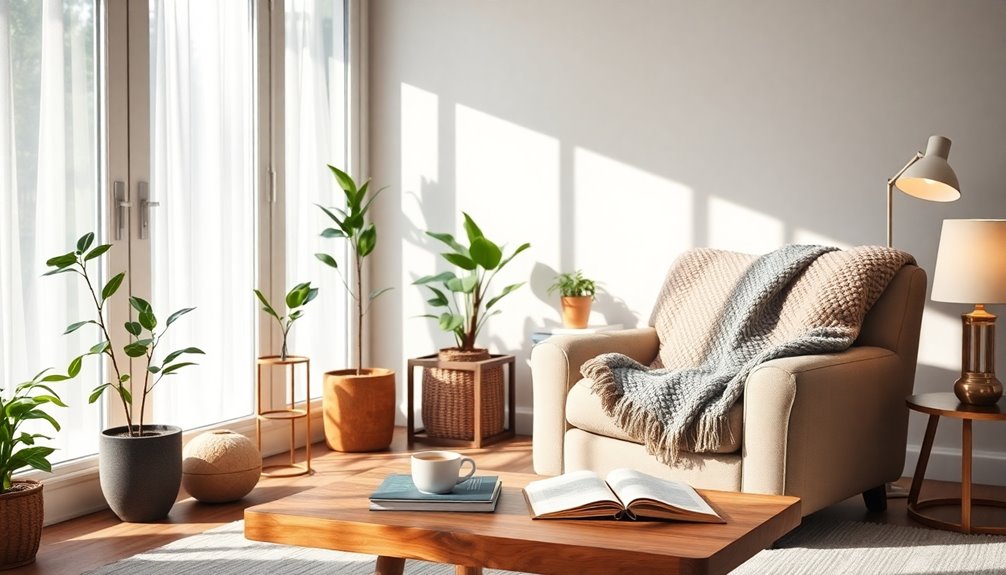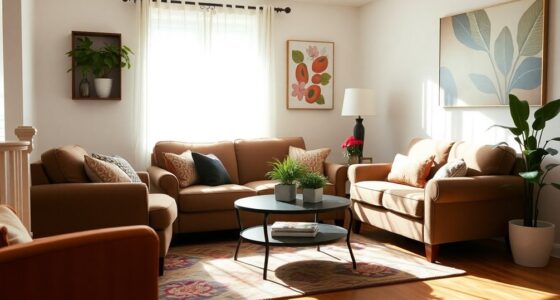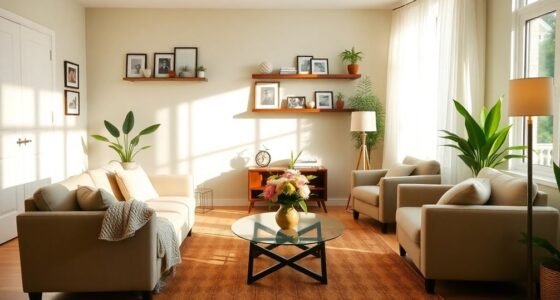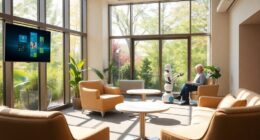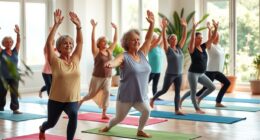To create a more comfortable and safe home for the elderly, start by choosing lighter color schemes to enhance visibility and brightness. Incorporate soft, non-slip rugs to add warmth while preventing slips. Guarantee adequate lighting with adjustable fixtures for various activities. Arrange furniture to maintain open pathways and upgrade flooring to minimize tripping hazards. Personalize spaces with meaningful decor and use multi-functional furniture to maximize space. Discover how to implement smart technology for further convenience and safety.
Key Takeaways
- Incorporate family photographs and personal heirlooms to enhance emotional well-being and connection to the living space.
- Use lighter color schemes and soft lighting to improve visibility and create a welcoming atmosphere.
- Arrange furniture to maintain clear pathways of at least 36 inches for easy navigation and accessibility.
- Install grab bars in bathrooms and hallways, ensuring they are visible and securely anchored for safety.
- Add vibrant textures like cozy throw blankets and pillows to promote comfort and a sense of belonging.
Understanding the Importance of Comfort and Safety in Elderly Homes
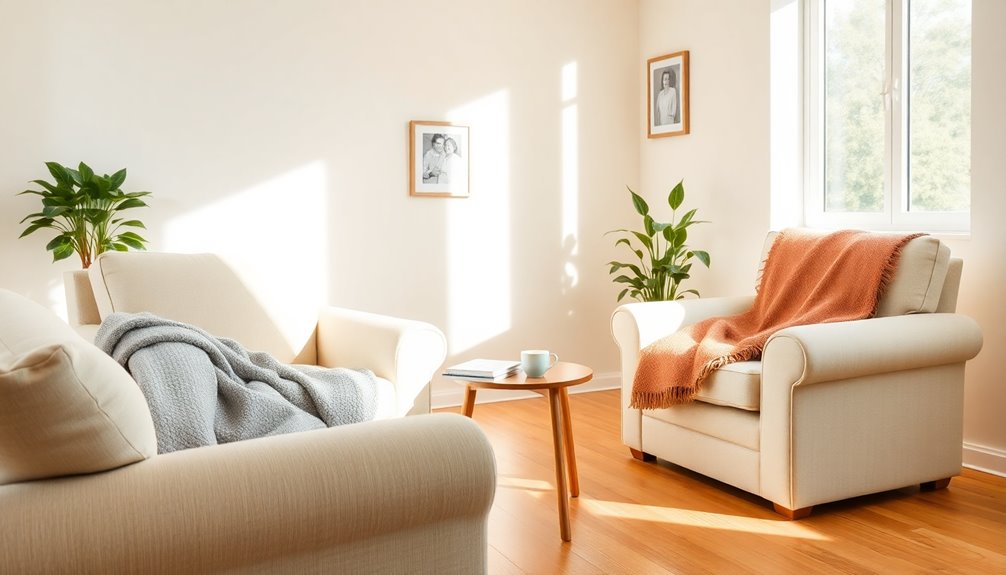
When you prioritize comfort and safety in elderly homes, you greatly enhance the quality of life for older adults.
By implementing thoughtful home modifications, you can create an environment that supports their independence. Universal design principles help guarantee spaces are accessible and flexible, which is crucial for aging residents.
You can reduce the risk of falls by removing tripping hazards and optimizing furniture layouts, making navigation easier. Additionally, proper lighting in high-traffic areas is essential for safety, improving visibility and preventing accidents.
Personalizing decor not only makes a space feel inviting but also boosts mental well-being, helping seniors feel connected to their surroundings.
Ultimately, these upgrades considerably contribute to a safer, more comfortable home.
Choosing Lighter Color Schemes for Improved Visibility
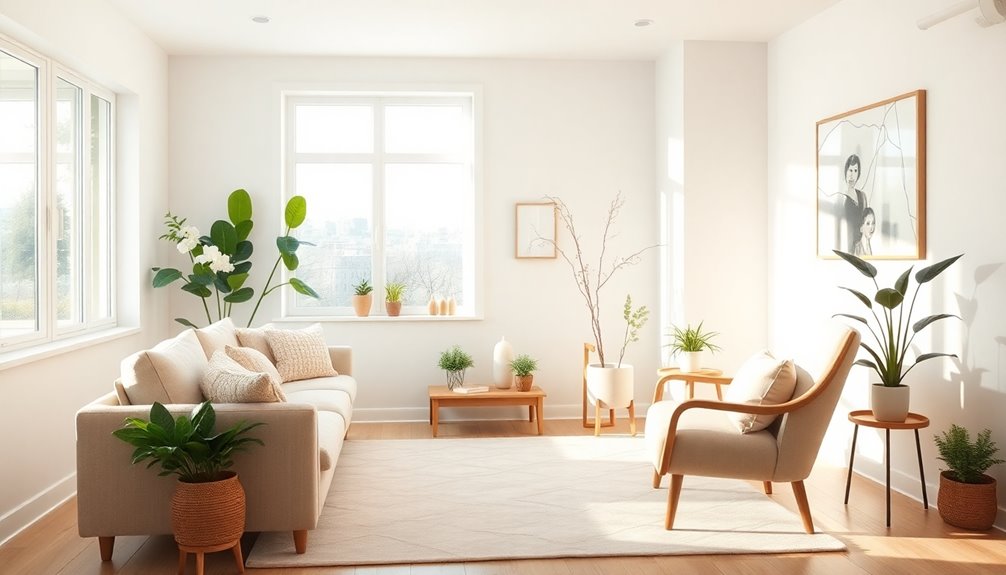
Choosing lighter color schemes can brighten up your rooms, creating a more inviting atmosphere. Not only do these colors enhance visibility, but they also make spaces feel larger and more open. Plus, using lighter shades can help you spot potential hazards, improving safety as you navigate your home. Incorporating large indoor plants can also enhance the decor while promoting a calming environment.
Enhance Room Brightness
Light-colored schemes can dramatically enhance room brightness, making it easier for elderly individuals to navigate their homes. By choosing lighter colors for walls and furnishings, you not only improve visibility but also create a more inviting atmosphere.
This simple change can considerably reduce the risk of accidents and falls.
- Soft whites and pastels reflect natural light effectively.
- High-gloss finishes amplify brightness, making spaces appear larger.
- Light colors contribute to a positive mental outlook.
- Bright environments reduce eye strain for aging eyes.
- Open and airy spaces help alleviate feelings of confinement.
Incorporating these lighter tones will make your home safer and more comfortable, ultimately improving the quality of life for the elderly loved ones in your care.
Create Spacious Illusion
To create a more spacious feel in your home, selecting lighter color schemes for walls and furnishings is key. Light colors, such as soft pastels and neutrals, enhance natural light reflection, making your spaces feel open and inviting.
This not only helps create a spacious illusion but also improves visibility, reducing strain on aging eyes. Consider painting ceilings in lighter shades to add height and make rooms appear less claustrophobic.
Incorporating light-colored furniture and decor minimizes visual clutter, allowing seniors to navigate their environment easily. Research shows that well-lit, lighter spaces can boost mood and well-being, fostering a sense of comfort and safety for elderly residents. Additionally, using earthy greens and blues as accent colors can enhance the connection to nature, promoting tranquility in the space.
Embrace light colors for a brighter, more inviting home.
Improve Safety Awareness
Enhancing visibility in your home can greatly improve safety awareness for elderly residents. By choosing lighter color schemes, you can create brighter and more inviting living spaces that reduce the risk of trips and falls.
Soft pastels and light neutrals reflect natural light, minimizing shadows that can hide hazards. High-contrast combinations, like light walls paired with dark furniture, help define pathways, making navigation easier.
- Use light colors in high-traffic areas, such as hallways and staircases.
- Choose non-glossy finishes to avoid glare.
- Incorporate bright accents for visual cues.
- Opt for light rugs to distinguish floors from furniture.
- Consider lighter colors for door frames and edges for better visibility.
These simple changes can greatly enhance safety and comfort at home. Additionally, integrating natural elements like plants can further brighten spaces while improving air quality.
Incorporating Soft, Non-Slip Rugs for Warmth and Safety
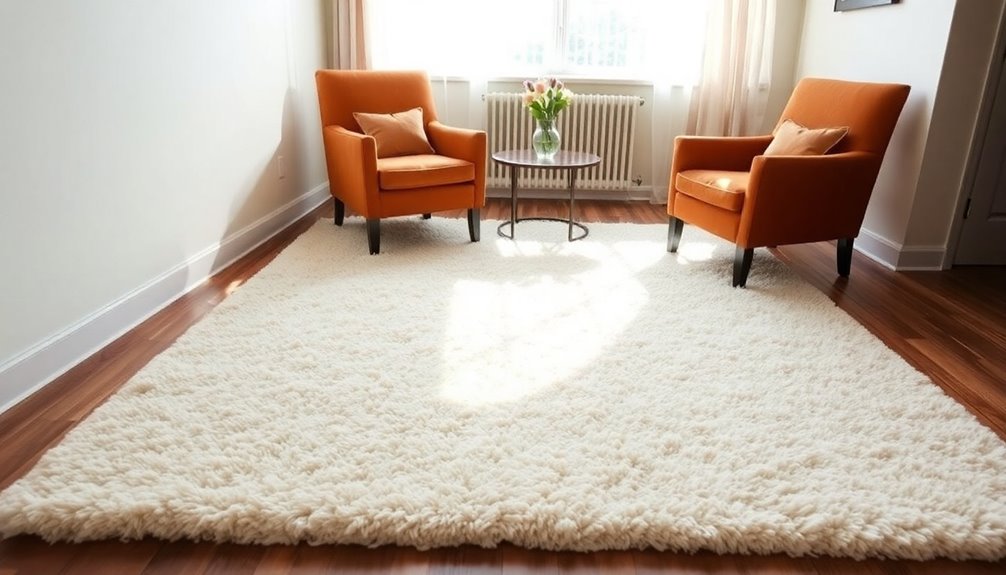
Rugs play an essential role in creating a safe and inviting atmosphere in elderly homes. Incorporating soft rugs and non-slip mats can greatly reduce the risk of slips and falls, providing a stable surface that minimizes tripping hazards.
Choose rugs with rubber backing or non-slip pads to keep them securely in place, especially in high-traffic areas like hallways and living rooms. Soft rugs not only add warmth and comfort but also absorb sound, creating a quieter environment that enhances well-being.
Opt for plush or wool materials to provide extra cushioning, making it easier for seniors to stand or walk comfortably. Regular maintenance and cleaning of non-slip rugs also promote hygiene, ensuring a safe and healthy home.
Ensuring Adequate Lighting With Adjustable Fixtures
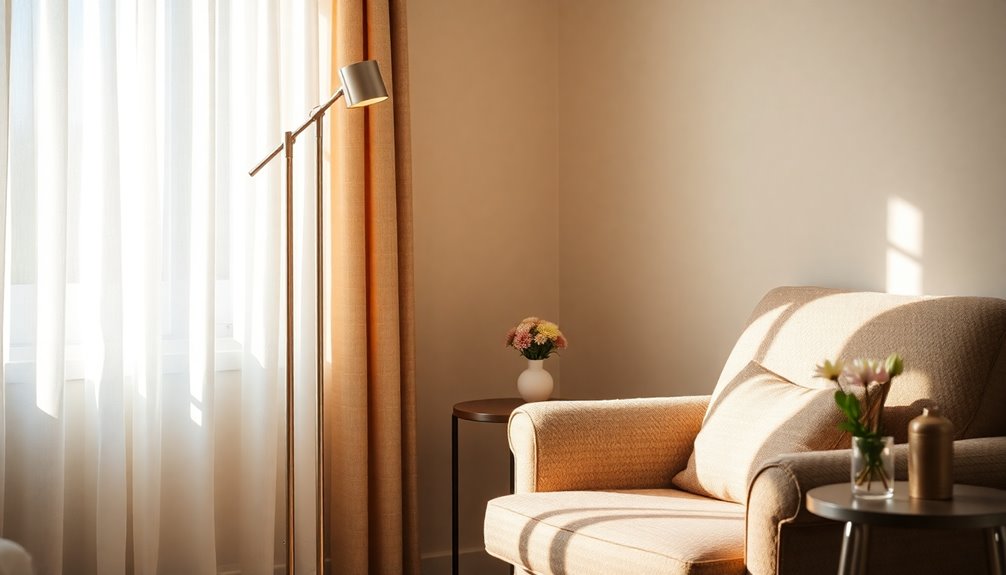
When it comes to lighting in your home, adjustable fixtures can make a big difference.
You can control brightness, adjust heights, and choose energy-efficient options to suit your needs.
These features not only enhance visibility but also create a cozy atmosphere that promotes comfort and safety.
Brightness Control Options
Having the right lighting can greatly impact your comfort and safety at home, especially as you age. Brightness control options, such as adjustable lighting fixtures, allow you to modify light levels to suit your needs.
By incorporating these features, you can create a safer, more inviting environment.
- Install dimmers for adjustable brightness while reading or relaxing.
- Use smart bulbs to change light intensity and color temperature.
- Add motion-sensor lights in hallways to reduce fall risks.
- Opt for daylight-mimicking bulbs to enhance your mood.
- Choose LED fixtures for energy efficiency and longer lifespan.
Additionally, consider using air purifiers with HEPA filtration to improve indoor air quality, which can also contribute to a healthier living space.
With these simple upgrades, you can considerably improve your daily living experience while ensuring comfort and safety in your home.
Adjustable Height Features
Adjustable height lighting fixtures can transform your living space by allowing you to customize illumination to fit your needs.
For seniors, this flexibility is essential for enhancing visibility and minimizing fall risks. Installing pendant lights with adjustable cords provides focused task lighting over areas like kitchen counters or reading nooks, making them more usable.
Additionally, floor lamps with adjustable heights adapt to different seating arrangements, ensuring light is directed where it's most needed, promoting safety and comfort.
By using dimmable LED bulbs in these adjustable fixtures, you can easily change brightness levels, reducing glare and eye strain. This is especially beneficial in homes with air purifiers, as improved air quality can further enhance overall health benefits and comfort.
These solutions not only enhance functionality but also create a more personalized and inviting atmosphere, contributing to your overall well-being.
Energy-Efficient Lighting Choices
How can you guarantee your home stays well-lit while being energy-efficient? Choosing energy-efficient lighting choices can make your home both comfortable and safe for older adults.
Start by installing LED bulbs, which provide bright, glare-free light while using up to 75% less energy. Incorporate adjustable fixtures like dimmable lights to cater to individual needs.
Motion-sensor lights are great for entryways, ensuring safety as they illuminate automatically. Task lighting, such as under-cabinet lights or reading lamps, prevents accidents by offering focused illumination.
Finally, consider smart lighting systems for easy voice-activated control. Regular maintenance of heat pump systems can further enhance energy efficiency in your home.
- LED bulbs for energy savings
- Dimmable fixtures for personalized brightness
- Motion-sensor lights for safety
- Task lighting for specific activities
- Smart lighting for convenience
Arranging Furniture to Create Open Pathways
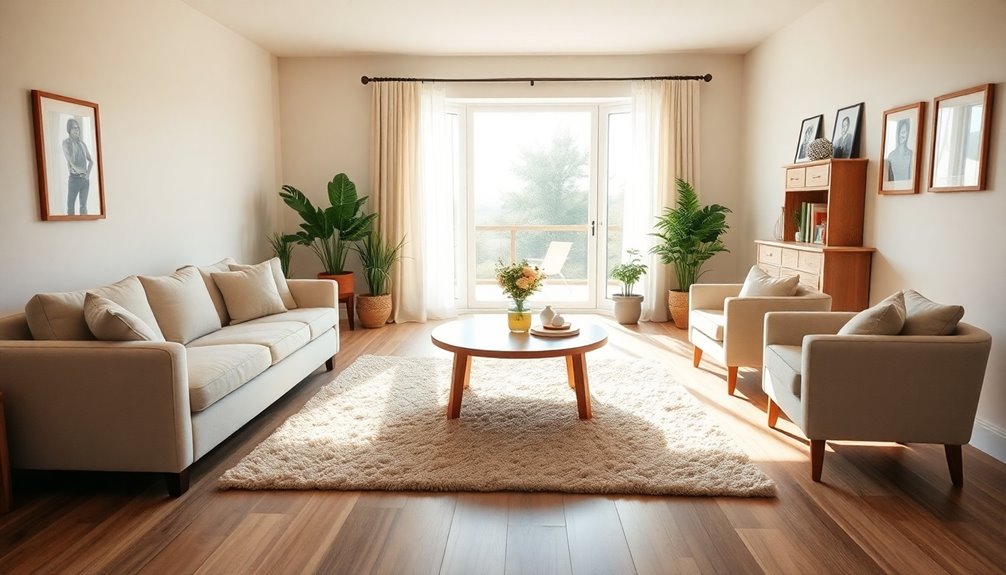
To guarantee safe mobility throughout the home, arranging furniture with thoughtful consideration is essential. Aim for at least 36 inches of clear pathway space to accommodate wheelchairs and walkers. This guarantees everyone can navigate easily and safely.
Avoid low or bulky furniture that obstructs sightlines, as this can create hazards for those with visual impairments or mobility challenges. Position sofas and chairs to face each other, encouraging social interaction while keeping walkways open.
Consider multi-functional furniture, like ottomans with storage, to reduce clutter and keep essentials accessible without blocking pathways. Regularly reassess your furniture arrangements, especially after introducing new items or changes in residents' health, to maintain a safe, functional living space. Additionally, regular vacuuming is crucial to prevent dirt accumulation, ensuring a clean environment that supports mobility and overall comfort.
Adding Grab Bars in Key Areas for Enhanced Support
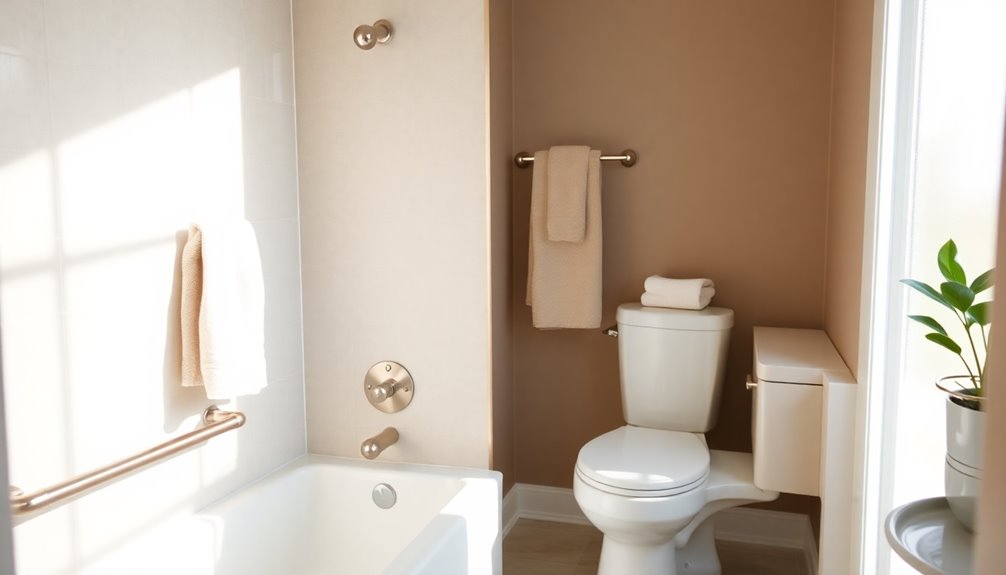
Adding grab bars in key areas of your home can greatly enhance safety for elderly residents.
Focus on ideal placement in bathrooms and staircases, where support is essential, while also considering stylish design options that complement your decor.
This way, you create both a functional and aesthetically pleasing environment for everyone.
Optimal Placement Locations
When considering the safety of elderly individuals in the home, ideal placement of grab bars is essential for enhancing support and preventing falls.
Focus on key areas where accidents frequently occur.
- Install grab bars around the toilet and shower to boost bathroom safety.
- Place them in hallways or near entryways for support during changes.
- Verify grab bars are 33 to 36 inches high for easy accessibility.
- Use contrasting colors for better visibility against wall surfaces.
- Regularly check that grab bars are securely anchored to withstand at least 250 pounds of pressure.
- Additionally, creating a safe home environment can help reduce the risk of emotional manipulation that may arise from stress and anxiety in elderly individuals.
Stylish Design Options**
How can you enhance safety without sacrificing style? Incorporating grab bars into your home decor is a practical solution that blends seamlessly with modern interior design. Choose grab bars that are both functional and aesthetically pleasing, with textured surfaces for better grip and a diameter of 1.25 to 1.5 inches for comfort. Install them at a height of 33 to 36 inches in high-risk areas like bathrooms and entryways. This way, you'll provide essential support while maintaining a sophisticated look. Additionally, being aware of narcissistic behaviors can help you navigate family dynamics during home modifications.
| Area | Grab Bar Height | Design Option |
|---|---|---|
| Shower | 33-36 inches | Sleek stainless steel |
| Toilet | 33-36 inches | Decorative finishes |
| Staircase | 33-36 inches | Stylish color options |
| Entryway | 33-36 inches | Wall-mounted art styles |
| Hallway | 33-36 inches | Custom designs available |
Upgrading Flooring to Minimize Tripping Hazards
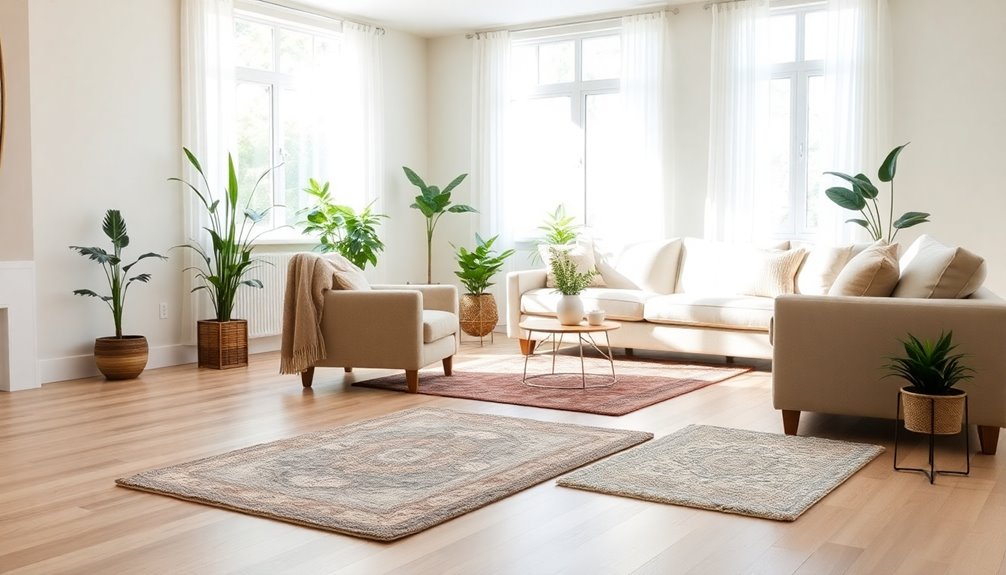
To create a safer living environment for the elderly, upgrading flooring is vital in minimizing tripping hazards.
Removing throw rugs and opting for wall-to-wall carpeting or non-slip vinyl flooring can greatly reduce risks.
It's important to keep hallways and high-traffic areas free from obstructions to guarantee safe navigation.
Installing slip-resistant materials like textured vinyl or rubber, especially in moisture-prone areas, helps prevent falls from slippery surfaces.
Regularly checking for wrinkles or bunches in current flooring can also reduce hazards.
- Choose low-pile carpet for stability and comfort.
- Consider non-slip vinyl in kitchens and bathrooms.
- Maintain clear pathways throughout the home.
- Regularly inspect flooring for repairs.
- Avoid slippery surfaces to enhance safety.
Additionally, implementing energy-saving features in your heat pump system can contribute to a more comfortable home environment.
Personalizing Spaces With Meaningful Decor

Creating a safe and comfortable home for the elderly goes beyond just upgrading flooring; it also involves infusing spaces with personal touches that reflect their history and personality.
Personalizing spaces with meaningful decor can greatly enhance their sense of belonging and emotional well-being. Incorporate family photographs and heirlooms, which not only add warmth but also spark conversations that foster connections.
Use vibrant colors and textures, like cozy throw blankets and pillows, to make the environment inviting. Engage in DIY projects, such as painting pots or creating table bouquets, allowing them to express creativity while boosting mental health.
Thoughtfully arranged decor supports mobility, keeping meaningful items easily accessible and promoting independence in their home.
Utilizing Multi-Functional Furniture for Space Efficiency
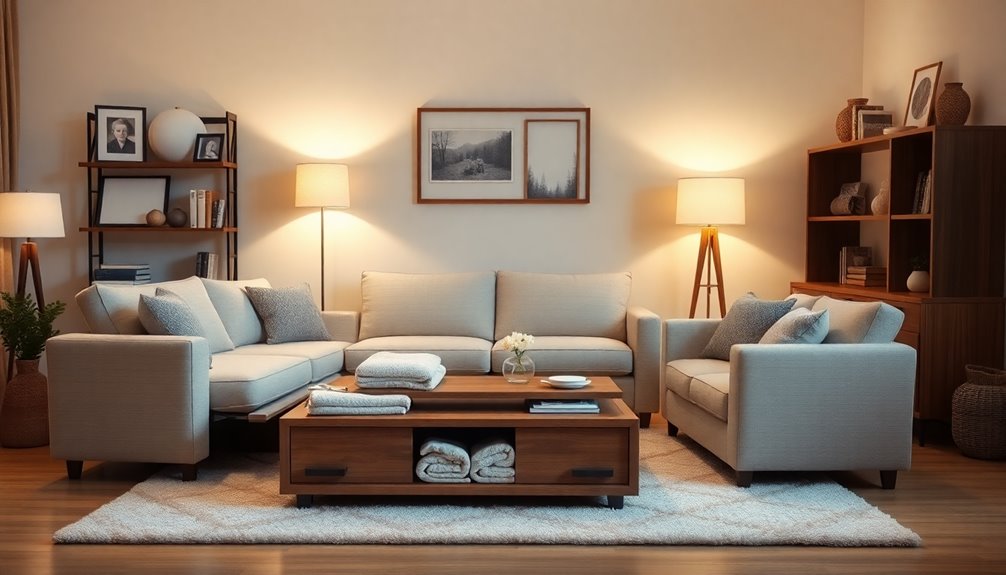
When you're looking to maximize space in an elderly home, utilizing multi-functional furniture is a smart solution. This type of furniture enhances space efficiency by serving multiple purposes, reducing clutter, and making life easier.
Here are some great options to contemplate:
- Sofa beds for comfortable seating that doubles as a sleeping area.
- Ottomans with storage to keep essentials organized while providing extra seating.
- Nesting tables that offer flexible surfaces without taking up too much room.
- Adjustable height tables for dining or working comfortably.
- Murphy beds or wall-mounted desks that transform a room's functionality without occupying permanent floor space.
Incorporating these pieces can create a more navigable and enjoyable living environment for seniors.
Implementing Smart Technology for Increased Convenience
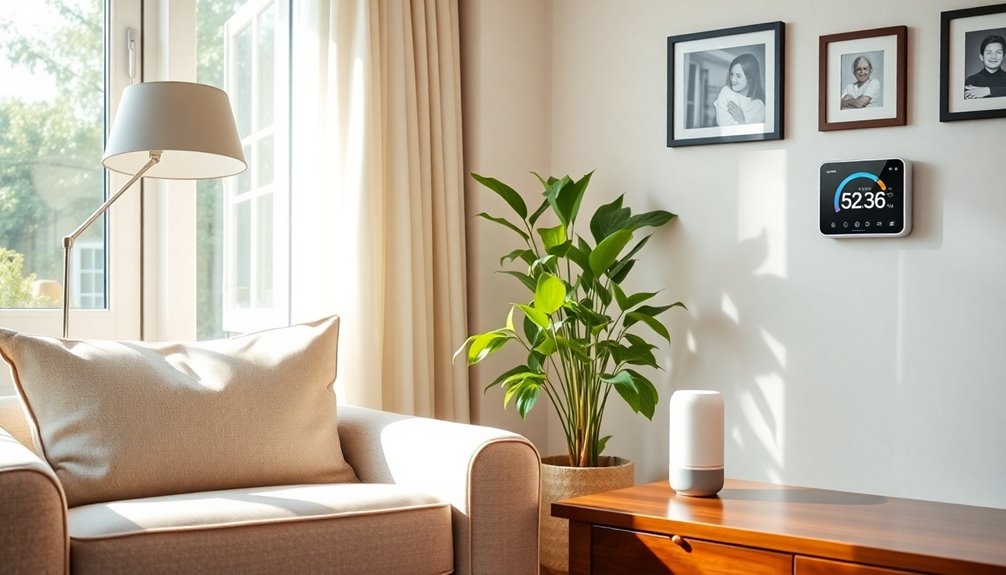
As technology continues to evolve, seniors can greatly benefit from implementing smart devices that enhance their daily lives.
Smart home solutions offer unparalleled convenience, allowing you to control lighting, temperature, and appliances without moving around your space. Voice-activated assistants make it easy to adjust your environment, while automated lighting systems help prevent falls by ensuring well-lit areas.
Smart doorbells and security cameras provide peace of mind, letting you see and communicate with visitors directly from your smartphone.
Smart thermostats learn your preferences, maintaining a comfortable atmosphere effortlessly. Additionally, voice-controlled speakers can play music, set reminders, and provide information, reducing feelings of isolation.
Embracing smart technology can remarkably improve your comfort and safety at home.
Frequently Asked Questions
How Can I Make My House Elderly Friendly?
To make your house elderly-friendly, start by installing grab bars and handrails in critical areas like bathrooms and staircases.
Improve lighting with bright, glare-free fixtures and motion sensors for better visibility.
Choose furniture with sturdy armrests and higher seating to aid shifts.
Remove throw rugs to eliminate tripping hazards, and guarantee your flooring is slip-resistant.
Finally, incorporate convenient landing spots near entryways for safe item placement while coming and going.
How to Make a Nursing Home Feel More Like Home?
To make a nursing home feel more like home, personalize the space with family photos and cherished keepsakes.
Incorporate soft furnishings like cozy blankets and throw pillows to add warmth.
Brighten the environment with vibrant artificial flower arrangements and guarantee comfortable seating in common areas to encourage social interaction.
Finally, use lighting that mimics natural light to create a welcoming atmosphere, helping residents feel more relaxed and at ease in their surroundings.
How Do I Make My Assisted Living Room Cozy?
To make your assisted living room cozy, start with comfortable seating that has sturdy armrests and higher seat heights.
Add soft rugs to warm up the space while minimizing slipping hazards.
Use adjustable lighting to create a warm ambiance, ensuring you have easy-to-reach switches.
Arrange your furniture for clear pathways, making it easier to navigate.
Finally, personalize the room with family photos and keepsakes to enhance your emotional connection and comfort in the space.
How to Design a Home for Old People?
To design a home for older adults, focus on accessibility and safety.
Start by ensuring entryways are well-lit and include convenient landing spots. Upgrade door hardware to lever-style handles for ease of use.
In bathrooms, install grab bars and non-slip flooring to prevent falls.
Optimize lighting throughout the home, especially in high-traffic areas.
Conclusion
By weaving these simple decor upgrades into your elderly home, you’re not just enhancing comfort; you’re creating a warm embrace that invites joy and safety. Each thoughtful choice, from soft rugs to smart technology, acts like a gentle hand guiding your loved ones through their daily lives. As you transform their space, you’ll find it becomes a tapestry of cherished memories and ease, where every corner whispers comfort and every moment sparkles with the warmth of home. In this journey of transformation, consider incorporating some of the latest elderlyfriendly home decor trends that prioritize both style and practicality. From adjustable lighting to contrast-rich color palettes, these innovations ensure that each space not only looks beautiful but also caters to the unique needs of seniors. As you embrace these trends, you’ll create an environment that fosters independence while maintaining the intimacy and warmth that makes a house truly feel like home.
